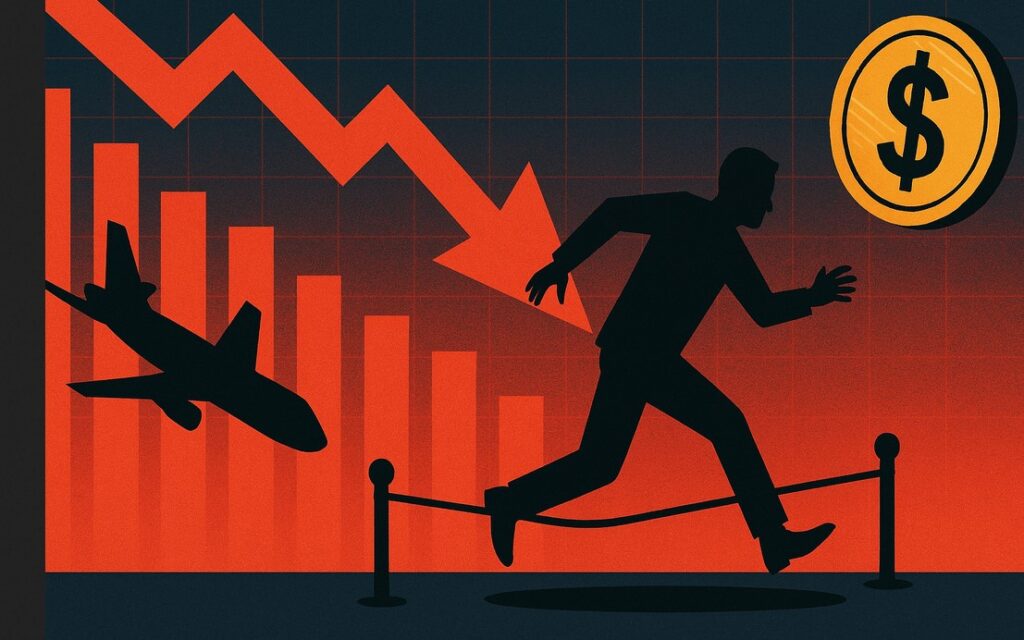- A “Black” anniversary…
- The potential tripwire for the next Black Monday…
- “Dumb” money is buying stocks. But “smart” money is quietly shifting to a specific gold play. And a government meeting on October 29th could send this strategy stratospheric. Go here to learn what the smart money is planning — and how you can ride its coattails…
Dear Reader,
Today I lower my head, belatedly… and pause in silent memory.
For the black crepe went up on Wall Street 38 years ago this week — Oct. 19, 1987 — a date which witnessed the bloodiest one-day carnage in market history.
The Dow Jones Industrial Average plummeted an impossible 22% that distant “Black Monday.”
A comparable blood-spilling today would plunge the index some 10,330 points.
I compare that October day to the ancient Battle of Cannae. Invincible Rome lost as many as 70,000 legionnaires to Hannibal’s armies — in one single day.
Or, to the first day of the Battle of the Somme, July 1, 1916. On that date nearly 20,000 British soldiers fell flat under German guns… and never got up.
It Literally Never Should Have Happened
I wrote recently that Black Monday was a 17-standard deviation event.
Probability theory suggests a 17-standard deviation event should never occur in the entire 4.6 billion year history of Earth.
Not on one single occasion. Yet it did on that black October day in 1987.
I wrote also that a complex statistical analysis of market history suggests that Black Mondays might occur with far more regularity.
That complex statistical analysis indicated you can expect a similar cataclysm once every 104 years.
Yet what sinister vortex could plunge today’s market into a Black Monday sequel?
Today we consider one harrowing possibility.
The Potential Tripwire for the Next Black Monday
Mr. Harley Bassman is a world-class expert in derivatives — what Warren Buffett has termed “weapons of mass destruction.”
This Bassman fellow lit out with one question in mind:
- The only question one cares about, identifying the tripwire that would tip our system into disequilibrium.
That is, what specific tripwire could turn a blue day on Wall Street into another Black Monday?
Mr. Bassman’s researches indicate there is. But what is it?
The potential villain of this black tale, a possible trigger for the next horror picture is:
Passive investing. That is correct — passive investing.
After the 2008 near-collapse, the emergency responders at the Federal Reserve inundated markets with oceans of liquidity.
The biblical-level flooding washed away existing financial signposts… and “fundamentals” no longer appeared to matter.
The tide rose, and all boats with it.
The Demise of “Active” Investing and the Triumph of “Passive” Investing
“Active” asset managers on the hunt for market inefficiencies could no longer separate winner from loser.
The heaping majority of all actively managed stock funds have underperformed their index since 2008.
Explains Larry Swedroe, former director of research at Buckingham Strategic Wealth:
“While it is possible to win that game, the odds of doing so are so poor that it’s simply not a prudent choice to play.”
“Passively” managed funds — contrarily — make no effort to pinpoint winners.
They are “passive” because they sit back on their oars… and let the flowing tide lift their boat.
They track an overall index or asset category — not the individual components.
It is a strategy that has yielded handsome dividends in this era of rising waters.
Passive investing has increased from perhaps 15% in 2007 to over half today’s market.
It is easy business so long as the tide continues to rise. Yet the risk is this:
When the tide recedes… it recedes.
Beware the Stampede
As Freedom Financial News contributor Jim Rickards explains:
- In a bull market, the effect is to amplify the upside as indexers pile into hot stocks like [Nvidia], Google and Apple. But a small sell-off can turn into a stampede as passive investors head for the exits all at once without regard to the fundamentals of a particular stock.
Meantime, today’s hyperconnected markets are staggeringly complex — far more complex than in 1987.
Mr. Rickards argues that this dizzying complexity leaves markets far more naked to “black swans” than odds alone suggest:
- One formal property of complex systems is that the size of the worst event that can happen is an exponential function of the system scale. This means that when a complex system’s scale is doubled, the systemic risk does not double; it may increase by a factor of 10 or more…
- This kind of sudden, unexpected crash that seems to emerge from nowhere is entirely consistent with the predictions of complexity theory. Increasing market scale correlates with exponentially larger market collapses…
No One Left to Catch the Falling Knife
Next comes the central question:
What happens when the critical threshold is passed… and passive investors rush the exit doors in the burning theater?
- Passive investors will be looking for active investors to “step up” and buy. The problem is there won’t be any active investors left or at least not enough to make a difference. The market crash will be like a runaway train with no brakes.
Consequently, warns Mr. Rickards:
“This is one more reason why the next stock market crash will be the greatest in history.”
I do not know if the next stock market crash will be the greatest in history.
There exist “circuit breakers” and other devices constructed to halt trading before the algorithms go amok… and before Chaos and Old Night can descend.
Perhaps they may work the trick.
Yet I would remind you that RMS Titanic was constructed with 16 watertight compartments designed to render her unsinkable.
She sank.
Regards,
Brian Maher
for Freedom Financial News




